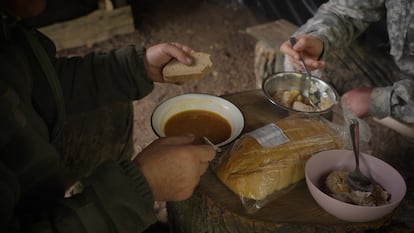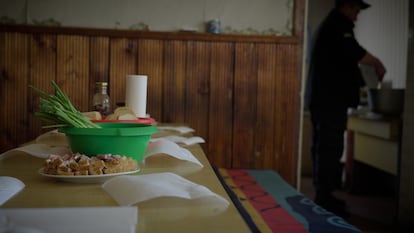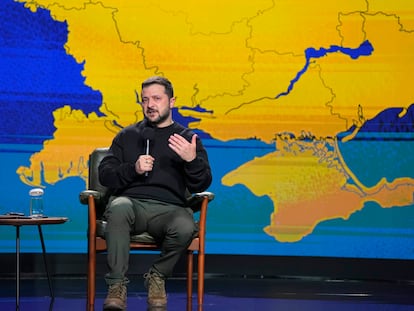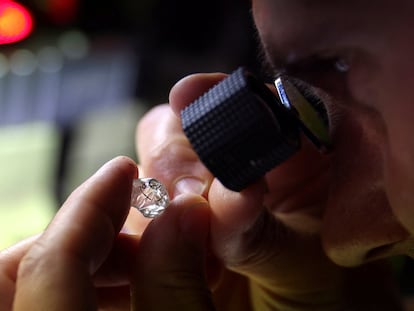Eating in a war zone: Pickles, soups and sausages support the morale of Ukrainians
The correspondent for EL PAÍS unveils (and tastes) the food preferred by soldiers and civilians in combat zones

I ate the best soup of my life this past May at the fire station in Huliaipole, a town just four miles from the frontlines in Ukraine. It was a solyanka, prepared by a firefighter who acted as cook. We ate the broth with pickles and pork, amid the background noise of an electric generator that allows the few remaining residents of the town to charge their phones.
The firefighters didn’t remember exactly when the power supply was interrupted. There have been too many months of fighting in the town. However, they precisely recalled a day when a Russian projectile pierced the station, damaging one of the two fire trucks and shattering the windows.
That simple lunch in May – consisting of solyanka, chives and bread with sausages – tasted heavenly. And not only because the soup was excellent: also because eating in a war zone is an essential exercise of comradery, to maintain the morale of the group.
Ukrainian soldiers face multiple adversities: the danger of death, being wounded, harsh weather and mental disorders. But they don’t lack food. The daily meals arrive punctually at the frontlines in vans: the soldiers collect their rations in pots and pans. And, along with the typical rations – sliced bread, bottled water, chocolate, or preserves – they get special care packages from volunteer organizations. But what the troops are most grateful for is the homemade food that they receive or buy from the families in the villages where they are stationed.

Ukraine is one of the five largest agricultural exporting countries. Its land – especially in the east – is known for being particularly fertile. In any corner – in a plot next to the train tracks, or in the garden of any house – Ukrainians plant and the land returns what they have planted in abundance. Canned vegetables and fruits are stored in the pantries of the military bases, in the kitchens of the houses that the soldiers occupy temporarily, in the bunkers where they live, or in improvised refrigerators underground. They dig a hole, bury the casing of an empty artillery shell and, inside, they place the food, which they will protect with some plastic.
Chives, pickles, garlic and tomatoes cannot be missing from a Ukrainian table. Pickled and fresh vegetables accompany stews and meat. Eggs from chickens and other birds, such as geese, are also common in the diet along the frontlines. And there’s also salo: pork loin fat cured for a few weeks, ideally served in thin, almost frozen strips. Salo is obligatory in Ukrainian vodka-drinking rituals, which toast the family, women and companions who have died. During these toasts, it’s normal to cry. Or, if there are no tears, there’s a silence that breaks the soul.
Alcohol is officially prohibited in the Ukrainian Armed Forces, but there’s always a bottle hidden away to celebrate a special occasion. If the troops are grateful for anything, it’s for a couple of bottles of homemade liquor (in addition to cartons of tobacco). Most rural households in Ukraine distill their own liquors from what they grow themselves: plums, grapes, nuts, or potatoes. The result is brandy, wine and vodka of the sort that could be used to fuel a tractor.
Drones and marinated tomatoes
There was a September night on the frontlines in Kupiansk that began with artillery fire and ended with a feast of homemade pasta, stuffed with cheese and potatoes. The SUV of Vladislav – the commander of a missile battery within Ukraine’s 14th Mechanized Brigade – was speeding down a forest road in his SUV to return to his base, a house in a village occupied by the army. But his rush wasn’t because it was dinner time: it was because he had to quickly get out of the position from where Vladislav’s unit had fired its rockets at the Russian troops. At any time, the enemy could return fire.
Vladislav parked his SUV under some trees, camouflaging it. While getting out of the vehicle, he heard the characteristic sound of a drone’s propellers: it was a Russian reconnaissance device approaching. Guns began to fire into the sunset, bullets rising into the sky from the forest. Vladislav gave the order to run the 300 feet that separated us from the house. Upon entering, this reporter and the soldiers left behind the rain and the threat of the drone. As the windows were covered with paper, the drones couldn’t tell if anyone lived in the house.
A young non-commissioned officer gave me a warm welcome, showing me two trays of varenikis prepared by a local resident. Varenikis are traditional Ukrainian fresh dough dumplings that are boiled and can be eaten with onion and sour cream.
Vladislav’s soldiers also served some marinated tomatoes like I’ve never eaten before – a gift from another neighbor. The man soaked the tomatoes from his garden for five days in a bucket filled with water, salt, sugar, onion, garlic, pepper, cherry and cranberry leaves. The magic touch was adding an aspirin or two. The result was a unique combination of flavors in which an acidic touch predominated.

Military families can also send food to the frontlines. This past October, I had lunch at the house where a battalion commander of the 1st Armored Brigade lived. It was a humble farm on the edge of a forest, along the Zaporizhzhia front. Tank crews lived in shelters dug underground, next to their tanks. The commander – one of the most decorated officers in Ukraine – ordered his cook and assistant to prepare a sumptuous dinner for us. You couldn’t miss a borscht soup (with beet and sour cream), the quintessential Ukrainian dish, which was served alongside buckwheat with bacon and sausages. The commander’s mother also sent along pickled gherkins and cupcakes.
The house was a mess, with wooden planks on the floor instead of tiles. In a room next to the meeting room where we had dinner, the command post was installed, with six screens that reported live on the enemy’s movement by land and air. As the soldiers savored the steaming pastries made by the commander’s mother, the screens fogged up.
Food isn’t in short supply on the frontlines, either. Soldiers’ shifts at the most advanced posts can last from one to four days. In the trenches and bunkers, they store groceries, preserves and even food that can be cooked quickly with a frying pan over gas. In July of 2022 – at the post of a company belonging to the 17th Armored Brigade, during an offensive towards the city of Nova Kakhovka – the gunner of a T-72 tank fired for 12 hours, without stopping for a moment. At dinner time, we arrived at a forest just three miles from the Russians, where six armored vehicles were awaiting orders to carry out artillery strikes. On the improvised table (made from pieces of wood), the men served up pickles and tomatoes, sausages, bread, salted fish and homemade kvass, all given as gifts by families in the province. Kvass is a sweet, refreshing, low-alcohol beverage, popular throughout the Slavic world, made from honey, rye, or malt. That afternoon, I ate more than the three T-72 crew members combined.
In the most exposed positions on the front, those within 1,600 feet of the enemy, or in operations that require hours of combat, food can consist of military rations that the army packs for its soldiers, or rations that have been donated by NATO. The content is very similar in both the Russian and Ukrainian armies: canned or packaged food, to be eaten instantly.
Some Ukrainian experts consulted by EL PAÍS — that is, soldiers on the front — assure that the quality of their rations is much better than what the Russians get, except for one product: tea. On my visits to the front, I’ve been collecting Russian army teabags, sealed with their distinctive green star, which I’ve found among the rubble of villages that had been occupied. I’ve made a promise to myself: I will drink this tea when the war is over.
The traditional Ukrainian recipe book is so rich that it helps to cope with the miseries of military life. But there’s something that soldiers like more, especially the younger ones: the fast food of American culture. The hot dogs prepared at gas stations are a symbol of Ukraine (as is borscht), with the sausage inside a long bun, covered in condiments. You will always find a gas station open not far from the frontlines, because they provide the necessary fuel for the thousands of vehicles in which the soldiers travel. They’re embassies of civilization… of the life that has been left behind after nearly two years of war.
A devotion to McDonald’s
If there’s one thing these younger Ukrainian soldiers dream of, it’s a McDonald’s hamburger. The fast food chain is the stuff of legend in Ukraine, as it has been in Russia — an icon of the hopes that capitalism promised to the post-Soviet world, an emblem in countries that were opening up to the American financial markets.
McDonald’s has closed in Russia, as part of a boycott action against the invasion. But in Ukraine, only some locations have been closed in the eastern regions, due to the threat of bombs. The closest establishments to the eastern front are in the city of Dnipro. Many soldiers make pilgrimages there, coming from Kharkiv or Zaporizhzhia, whenever they have a few days off. They travel up to three hours to eat at McDonald’s.
I asked Emil Prykhodko, a 27-year-old friend from Zaporizhzhia who occasionally escapes to Dinpro to eat a McDonald’s burger, about Ukraine’s devotion to American fast food. “It’s very good quality, better than in other European countries, like Germany or France. It’s crap there,” he notes. “McDonald’s in Ukraine has nothing to do with that.”
In October, I finally went to a McDonald’s in Kyiv. I ordered six different products, and they seemed like the same “crap” as anywhere else. However, I understand that a dish is often appreciated not only for its quality, but also for the emotional component that accompanies it. Just like the simple solyanka that I enjoyed so much that afternoon with the firefighters of Huliaipole.
Sign up for our weekly newsletter to get more English-language news coverage from EL PAÍS USA Edition
Tu suscripción se está usando en otro dispositivo
¿Quieres añadir otro usuario a tu suscripción?
Si continúas leyendo en este dispositivo, no se podrá leer en el otro.
FlechaTu suscripción se está usando en otro dispositivo y solo puedes acceder a EL PAÍS desde un dispositivo a la vez.
Si quieres compartir tu cuenta, cambia tu suscripción a la modalidad Premium, así podrás añadir otro usuario. Cada uno accederá con su propia cuenta de email, lo que os permitirá personalizar vuestra experiencia en EL PAÍS.
¿Tienes una suscripción de empresa? Accede aquí para contratar más cuentas.
En el caso de no saber quién está usando tu cuenta, te recomendamos cambiar tu contraseña aquí.
Si decides continuar compartiendo tu cuenta, este mensaje se mostrará en tu dispositivo y en el de la otra persona que está usando tu cuenta de forma indefinida, afectando a tu experiencia de lectura. Puedes consultar aquí los términos y condiciones de la suscripción digital.
More information
Archived In
Últimas noticias
Most viewed
- David King, chemist: ‘There are scientists studying how to cool the planet; nobody should stop these experiments from happening’
- Reinhard Genzel, Nobel laureate in physics: ‘One-minute videos will never give you the truth’
- Mexico completes its trade shift with the entry into force of tariffs on China and countries without trade agreements
- Oona Chaplin: ‘I told James Cameron that I was living in a treehouse and starting a permaculture project with a friend’
- Sinaloa Cartel war is taking its toll on Los Chapitos











































